Assessment Guide for Supporting Indigenous Education
VerifiedAdded on 2022/11/23
|9
|2079
|479
AI Summary
This assessment guide covers various aspects of supporting Indigenous education, including cultural context, intentional teaching, pastoral programs, place-based learning, and hearing loss in Indigenous children. It provides strategies and ideas for teachers to create a culturally inclusive learning environment and empower Indigenous students.
Contribute Materials
Your contribution can guide someone’s learning journey. Share your
documents today.
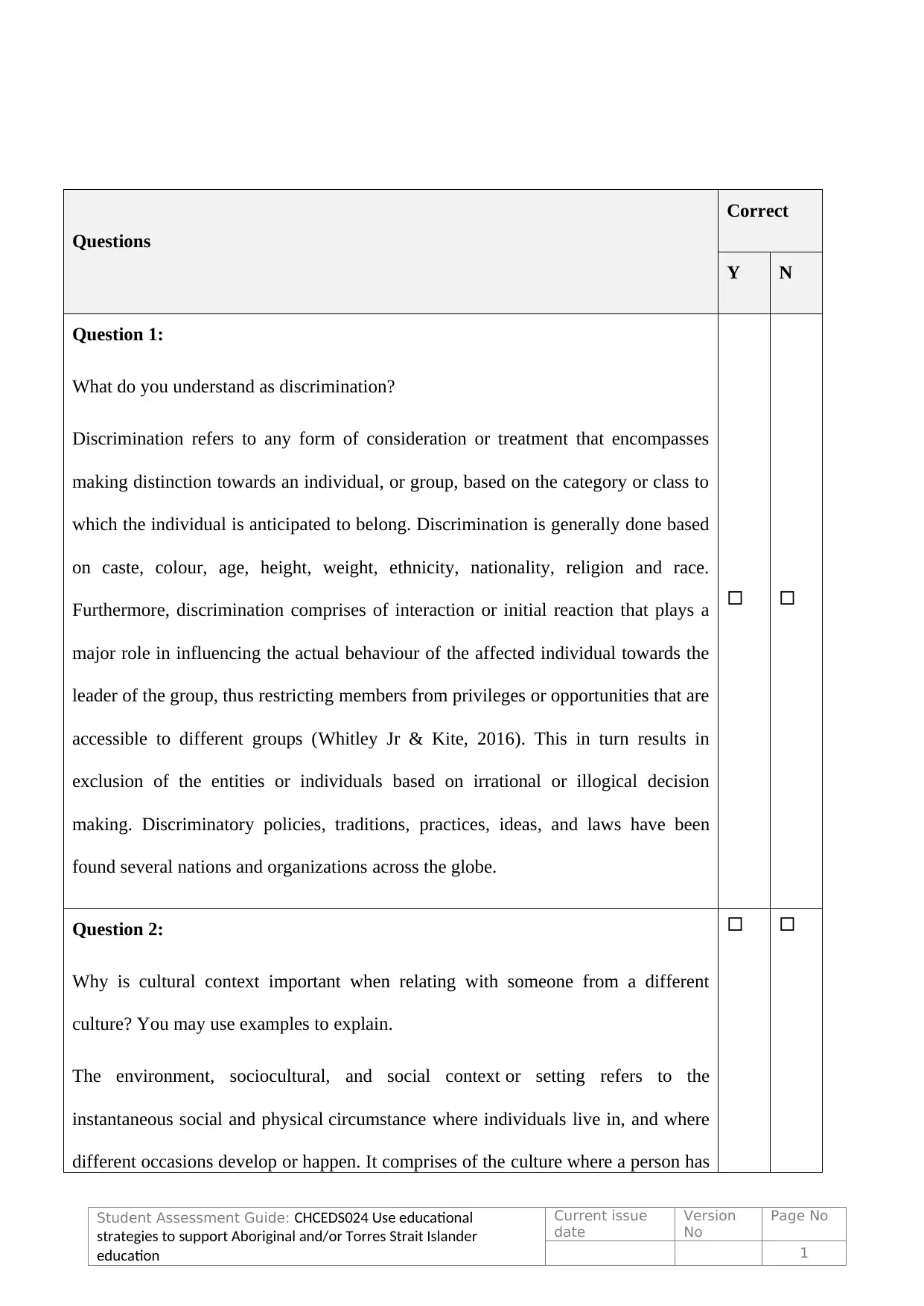
Questions
Correct
Y N
Question 1:
What do you understand as discrimination?
Discrimination refers to any form of consideration or treatment that encompasses
making distinction towards an individual, or group, based on the category or class to
which the individual is anticipated to belong. Discrimination is generally done based
on caste, colour, age, height, weight, ethnicity, nationality, religion and race.
Furthermore, discrimination comprises of interaction or initial reaction that plays a
major role in influencing the actual behaviour of the affected individual towards the
leader of the group, thus restricting members from privileges or opportunities that are
accessible to different groups (Whitley Jr & Kite, 2016). This in turn results in
exclusion of the entities or individuals based on irrational or illogical decision
making. Discriminatory policies, traditions, practices, ideas, and laws have been
found several nations and organizations across the globe.
Question 2:
Why is cultural context important when relating with someone from a different
culture? You may use examples to explain.
The environment, sociocultural, and social context or setting refers to the
instantaneous social and physical circumstance where individuals live in, and where
different occasions develop or happen. It comprises of the culture where a person has
Student Assessment Guide: CHCEDS024 Use educational
strategies to support Aboriginal and/or Torres Strait Islander
education
Current issue
date
Version
No
Page No
1
Correct
Y N
Question 1:
What do you understand as discrimination?
Discrimination refers to any form of consideration or treatment that encompasses
making distinction towards an individual, or group, based on the category or class to
which the individual is anticipated to belong. Discrimination is generally done based
on caste, colour, age, height, weight, ethnicity, nationality, religion and race.
Furthermore, discrimination comprises of interaction or initial reaction that plays a
major role in influencing the actual behaviour of the affected individual towards the
leader of the group, thus restricting members from privileges or opportunities that are
accessible to different groups (Whitley Jr & Kite, 2016). This in turn results in
exclusion of the entities or individuals based on irrational or illogical decision
making. Discriminatory policies, traditions, practices, ideas, and laws have been
found several nations and organizations across the globe.
Question 2:
Why is cultural context important when relating with someone from a different
culture? You may use examples to explain.
The environment, sociocultural, and social context or setting refers to the
instantaneous social and physical circumstance where individuals live in, and where
different occasions develop or happen. It comprises of the culture where a person has
Student Assessment Guide: CHCEDS024 Use educational
strategies to support Aboriginal and/or Torres Strait Islander
education
Current issue
date
Version
No
Page No
1
Secure Best Marks with AI Grader
Need help grading? Try our AI Grader for instant feedback on your assignments.
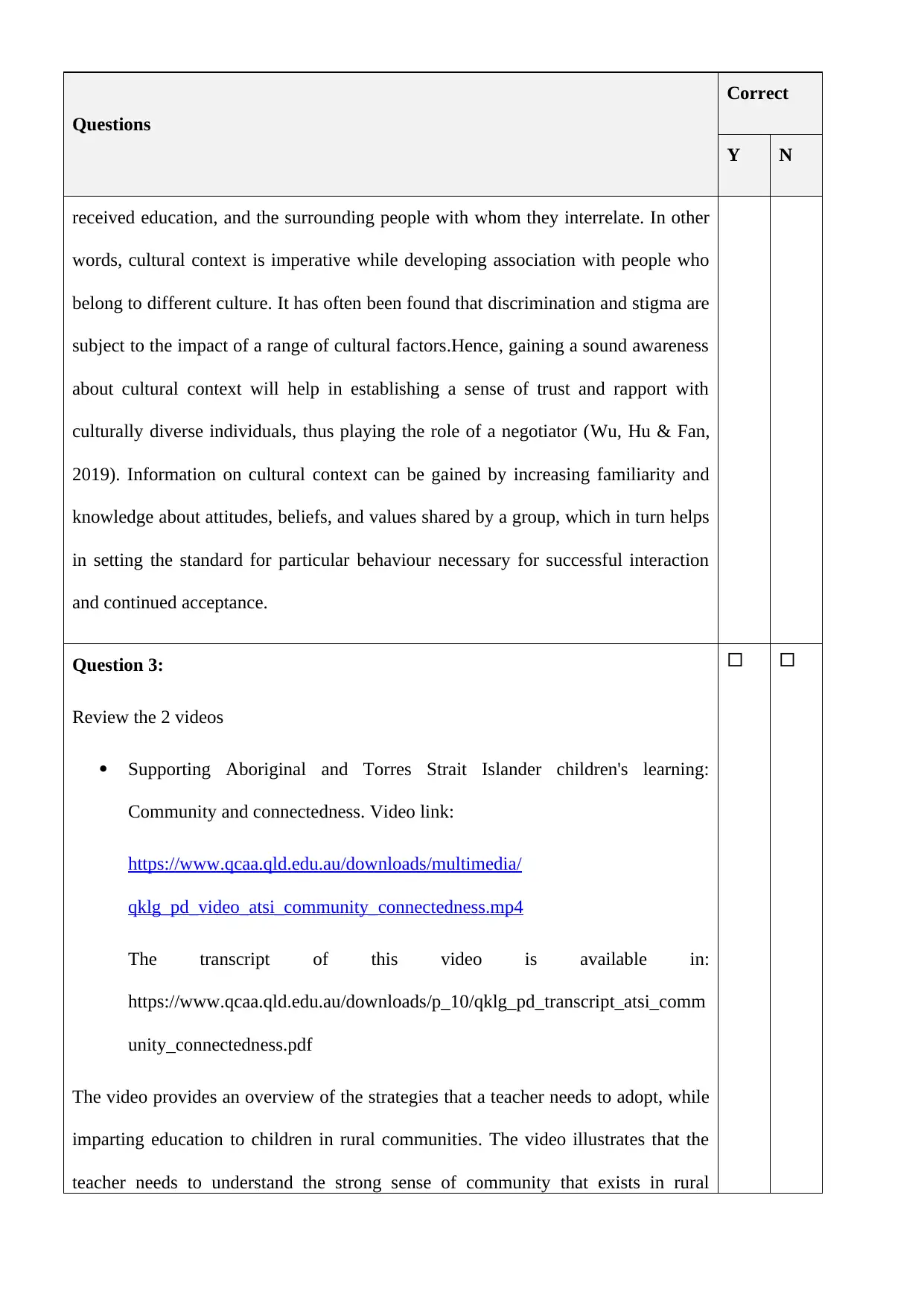
Questions
Correct
Y N
received education, and the surrounding people with whom they interrelate. In other
words, cultural context is imperative while developing association with people who
belong to different culture. It has often been found that discrimination and stigma are
subject to the impact of a range of cultural factors.Hence, gaining a sound awareness
about cultural context will help in establishing a sense of trust and rapport with
culturally diverse individuals, thus playing the role of a negotiator (Wu, Hu & Fan,
2019). Information on cultural context can be gained by increasing familiarity and
knowledge about attitudes, beliefs, and values shared by a group, which in turn helps
in setting the standard for particular behaviour necessary for successful interaction
and continued acceptance.
Question 3:
Review the 2 videos
Supporting Aboriginal and Torres Strait Islander children's learning:
Community and connectedness. Video link:
https://www.qcaa.qld.edu.au/downloads/multimedia/
qklg_pd_video_atsi_community_connectedness.mp4
The transcript of this video is available in:
https://www.qcaa.qld.edu.au/downloads/p_10/qklg_pd_transcript_atsi_comm
unity_connectedness.pdf
The video provides an overview of the strategies that a teacher needs to adopt, while
imparting education to children in rural communities. The video illustrates that the
teacher needs to understand the strong sense of community that exists in rural
Correct
Y N
received education, and the surrounding people with whom they interrelate. In other
words, cultural context is imperative while developing association with people who
belong to different culture. It has often been found that discrimination and stigma are
subject to the impact of a range of cultural factors.Hence, gaining a sound awareness
about cultural context will help in establishing a sense of trust and rapport with
culturally diverse individuals, thus playing the role of a negotiator (Wu, Hu & Fan,
2019). Information on cultural context can be gained by increasing familiarity and
knowledge about attitudes, beliefs, and values shared by a group, which in turn helps
in setting the standard for particular behaviour necessary for successful interaction
and continued acceptance.
Question 3:
Review the 2 videos
Supporting Aboriginal and Torres Strait Islander children's learning:
Community and connectedness. Video link:
https://www.qcaa.qld.edu.au/downloads/multimedia/
qklg_pd_video_atsi_community_connectedness.mp4
The transcript of this video is available in:
https://www.qcaa.qld.edu.au/downloads/p_10/qklg_pd_transcript_atsi_comm
unity_connectedness.pdf
The video provides an overview of the strategies that a teacher needs to adopt, while
imparting education to children in rural communities. The video illustrates that the
teacher needs to understand the strong sense of community that exists in rural
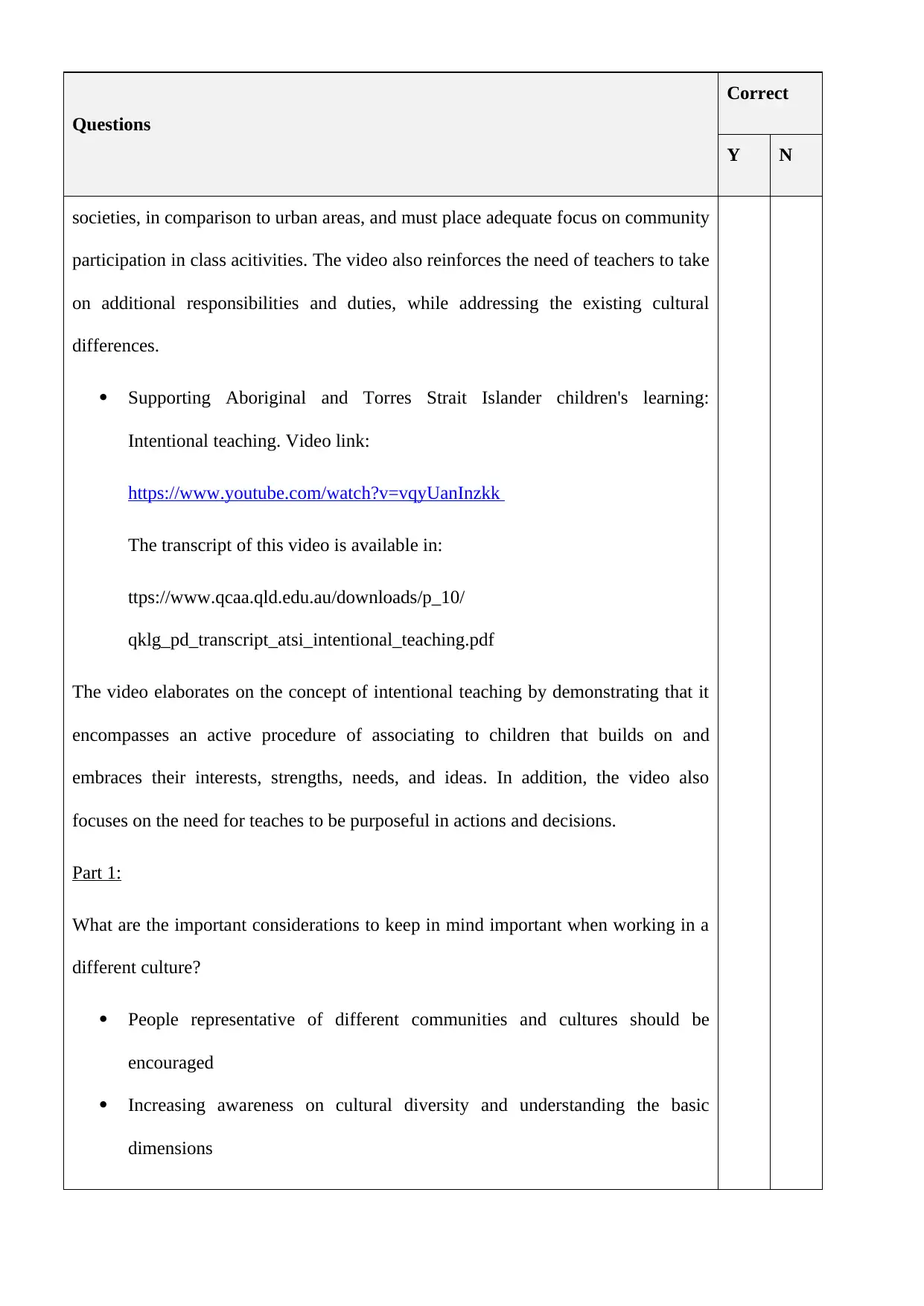
Questions
Correct
Y N
societies, in comparison to urban areas, and must place adequate focus on community
participation in class acitivities. The video also reinforces the need of teachers to take
on additional responsibilities and duties, while addressing the existing cultural
differences.
Supporting Aboriginal and Torres Strait Islander children's learning:
Intentional teaching. Video link:
https://www.youtube.com/watch?v=vqyUanInzkk
The transcript of this video is available in:
ttps://www.qcaa.qld.edu.au/downloads/p_10/
qklg_pd_transcript_atsi_intentional_teaching.pdf
The video elaborates on the concept of intentional teaching by demonstrating that it
encompasses an active procedure of associating to children that builds on and
embraces their interests, strengths, needs, and ideas. In addition, the video also
focuses on the need for teaches to be purposeful in actions and decisions.
Part 1:
What are the important considerations to keep in mind important when working in a
different culture?
People representative of different communities and cultures should be
encouraged
Increasing awareness on cultural diversity and understanding the basic
dimensions
Correct
Y N
societies, in comparison to urban areas, and must place adequate focus on community
participation in class acitivities. The video also reinforces the need of teachers to take
on additional responsibilities and duties, while addressing the existing cultural
differences.
Supporting Aboriginal and Torres Strait Islander children's learning:
Intentional teaching. Video link:
https://www.youtube.com/watch?v=vqyUanInzkk
The transcript of this video is available in:
ttps://www.qcaa.qld.edu.au/downloads/p_10/
qklg_pd_transcript_atsi_intentional_teaching.pdf
The video elaborates on the concept of intentional teaching by demonstrating that it
encompasses an active procedure of associating to children that builds on and
embraces their interests, strengths, needs, and ideas. In addition, the video also
focuses on the need for teaches to be purposeful in actions and decisions.
Part 1:
What are the important considerations to keep in mind important when working in a
different culture?
People representative of different communities and cultures should be
encouraged
Increasing awareness on cultural diversity and understanding the basic
dimensions
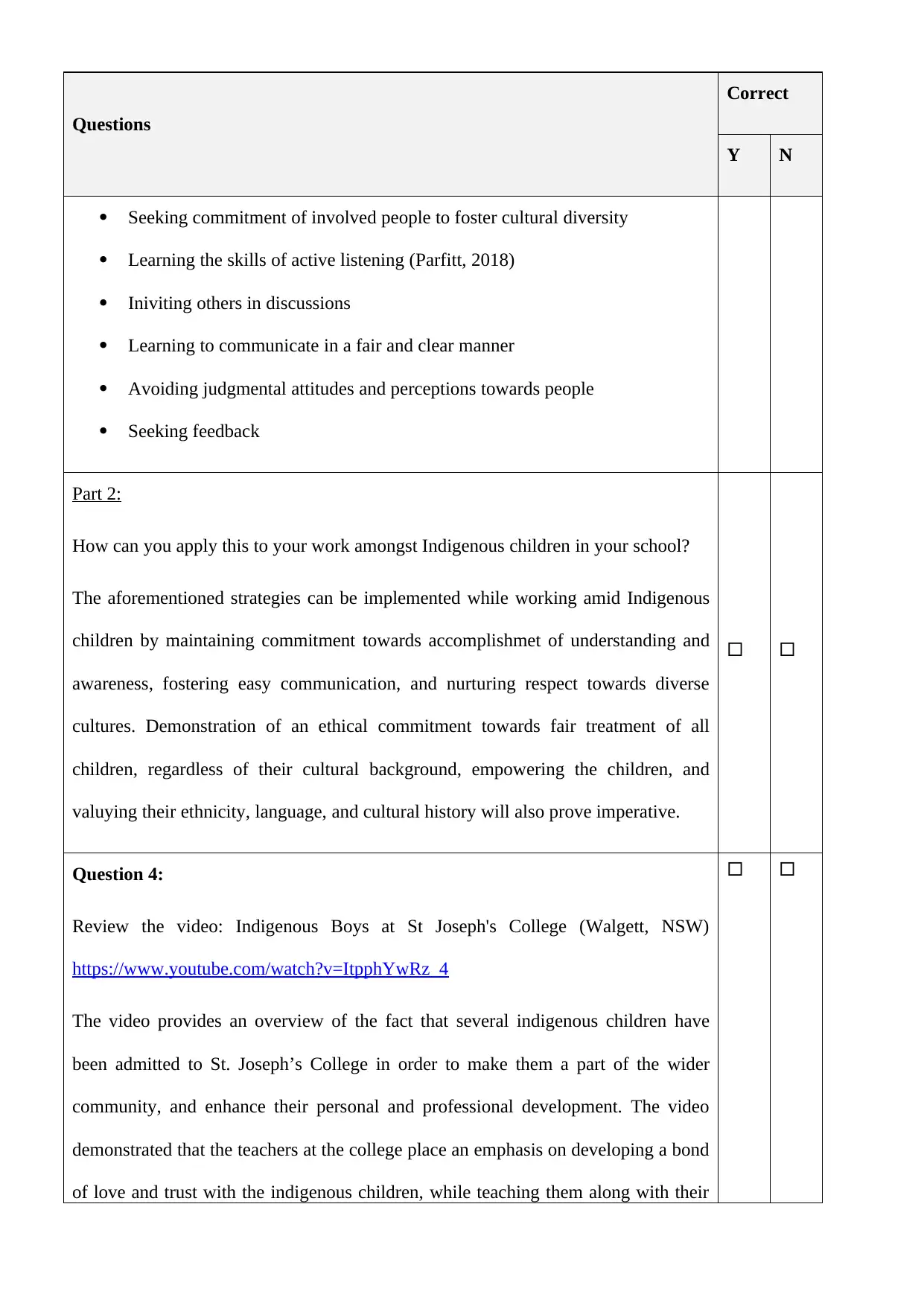
Questions
Correct
Y N
Seeking commitment of involved people to foster cultural diversity
Learning the skills of active listening (Parfitt, 2018)
Iniviting others in discussions
Learning to communicate in a fair and clear manner
Avoiding judgmental attitudes and perceptions towards people
Seeking feedback
Part 2:
How can you apply this to your work amongst Indigenous children in your school?
The aforementioned strategies can be implemented while working amid Indigenous
children by maintaining commitment towards accomplishmet of understanding and
awareness, fostering easy communication, and nurturing respect towards diverse
cultures. Demonstration of an ethical commitment towards fair treatment of all
children, regardless of their cultural background, empowering the children, and
valuying their ethnicity, language, and cultural history will also prove imperative.
Question 4:
Review the video: Indigenous Boys at St Joseph's College (Walgett, NSW)
https://www.youtube.com/watch?v=ItpphYwRz_4
The video provides an overview of the fact that several indigenous children have
been admitted to St. Joseph’s College in order to make them a part of the wider
community, and enhance their personal and professional development. The video
demonstrated that the teachers at the college place an emphasis on developing a bond
of love and trust with the indigenous children, while teaching them along with their
Correct
Y N
Seeking commitment of involved people to foster cultural diversity
Learning the skills of active listening (Parfitt, 2018)
Iniviting others in discussions
Learning to communicate in a fair and clear manner
Avoiding judgmental attitudes and perceptions towards people
Seeking feedback
Part 2:
How can you apply this to your work amongst Indigenous children in your school?
The aforementioned strategies can be implemented while working amid Indigenous
children by maintaining commitment towards accomplishmet of understanding and
awareness, fostering easy communication, and nurturing respect towards diverse
cultures. Demonstration of an ethical commitment towards fair treatment of all
children, regardless of their cultural background, empowering the children, and
valuying their ethnicity, language, and cultural history will also prove imperative.
Question 4:
Review the video: Indigenous Boys at St Joseph's College (Walgett, NSW)
https://www.youtube.com/watch?v=ItpphYwRz_4
The video provides an overview of the fact that several indigenous children have
been admitted to St. Joseph’s College in order to make them a part of the wider
community, and enhance their personal and professional development. The video
demonstrated that the teachers at the college place an emphasis on developing a bond
of love and trust with the indigenous children, while teaching them along with their
Secure Best Marks with AI Grader
Need help grading? Try our AI Grader for instant feedback on your assignments.
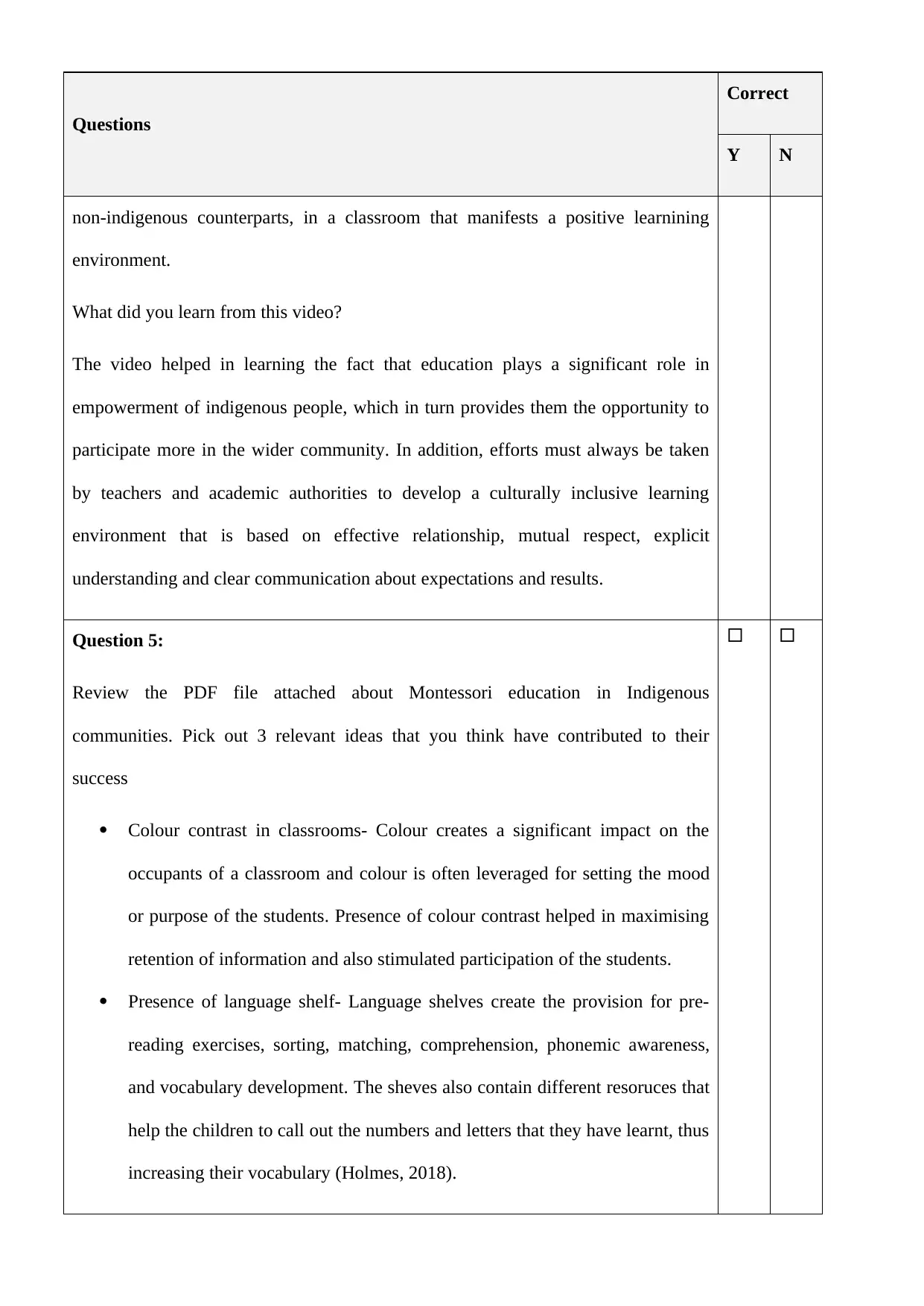
Questions
Correct
Y N
non-indigenous counterparts, in a classroom that manifests a positive learnining
environment.
What did you learn from this video?
The video helped in learning the fact that education plays a significant role in
empowerment of indigenous people, which in turn provides them the opportunity to
participate more in the wider community. In addition, efforts must always be taken
by teachers and academic authorities to develop a culturally inclusive learning
environment that is based on effective relationship, mutual respect, explicit
understanding and clear communication about expectations and results.
Question 5:
Review the PDF file attached about Montessori education in Indigenous
communities. Pick out 3 relevant ideas that you think have contributed to their
success
Colour contrast in classrooms- Colour creates a significant impact on the
occupants of a classroom and colour is often leveraged for setting the mood
or purpose of the students. Presence of colour contrast helped in maximising
retention of information and also stimulated participation of the students.
Presence of language shelf- Language shelves create the provision for pre-
reading exercises, sorting, matching, comprehension, phonemic awareness,
and vocabulary development. The sheves also contain different resoruces that
help the children to call out the numbers and letters that they have learnt, thus
increasing their vocabulary (Holmes, 2018).
Correct
Y N
non-indigenous counterparts, in a classroom that manifests a positive learnining
environment.
What did you learn from this video?
The video helped in learning the fact that education plays a significant role in
empowerment of indigenous people, which in turn provides them the opportunity to
participate more in the wider community. In addition, efforts must always be taken
by teachers and academic authorities to develop a culturally inclusive learning
environment that is based on effective relationship, mutual respect, explicit
understanding and clear communication about expectations and results.
Question 5:
Review the PDF file attached about Montessori education in Indigenous
communities. Pick out 3 relevant ideas that you think have contributed to their
success
Colour contrast in classrooms- Colour creates a significant impact on the
occupants of a classroom and colour is often leveraged for setting the mood
or purpose of the students. Presence of colour contrast helped in maximising
retention of information and also stimulated participation of the students.
Presence of language shelf- Language shelves create the provision for pre-
reading exercises, sorting, matching, comprehension, phonemic awareness,
and vocabulary development. The sheves also contain different resoruces that
help the children to call out the numbers and letters that they have learnt, thus
increasing their vocabulary (Holmes, 2018).
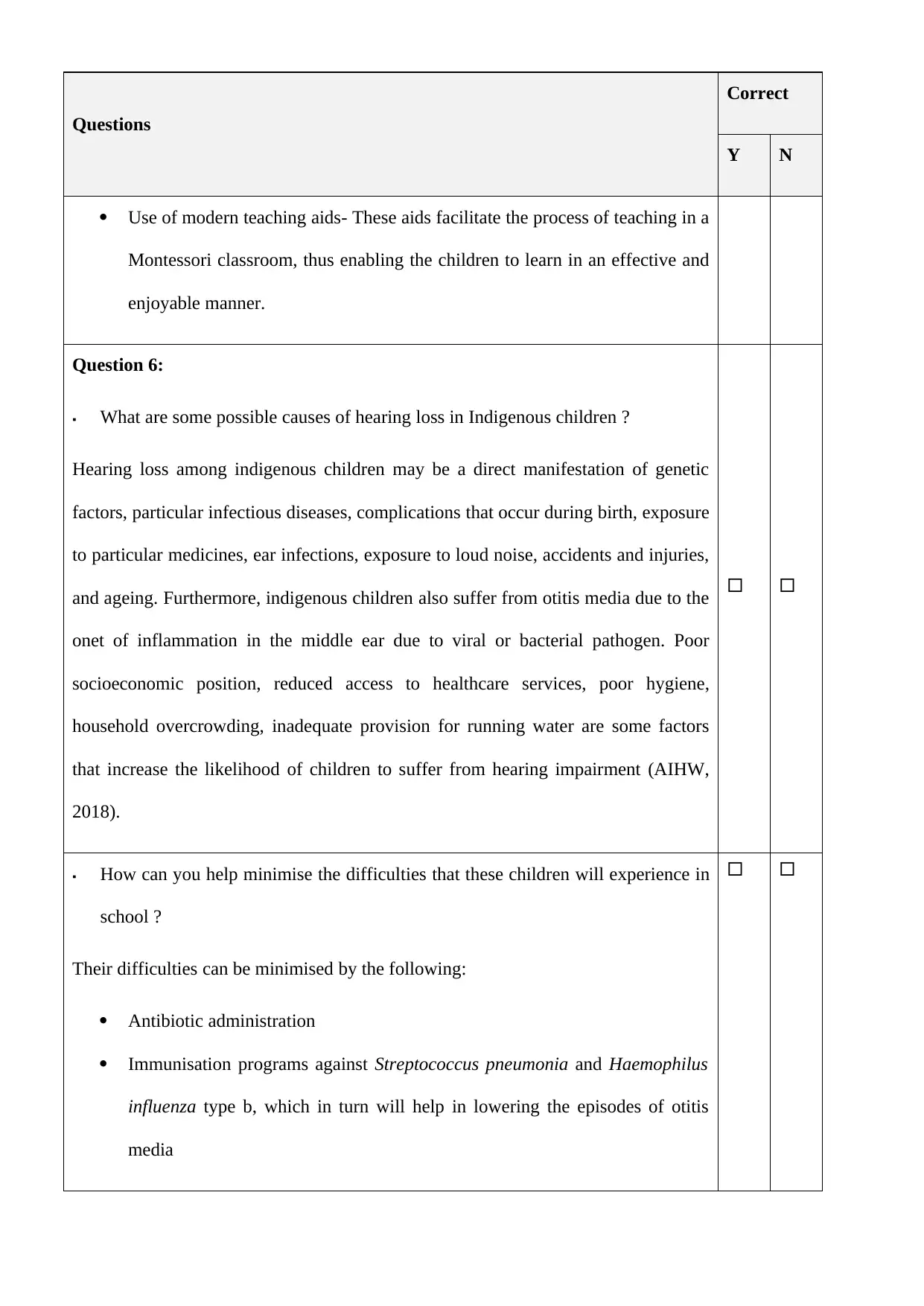
Questions
Correct
Y N
Use of modern teaching aids- These aids facilitate the process of teaching in a
Montessori classroom, thus enabling the children to learn in an effective and
enjoyable manner.
Question 6:
What are some possible causes of hearing loss in Indigenous children ?
Hearing loss among indigenous children may be a direct manifestation of genetic
factors, particular infectious diseases, complications that occur during birth, exposure
to particular medicines, ear infections, exposure to loud noise, accidents and injuries,
and ageing. Furthermore, indigenous children also suffer from otitis media due to the
onet of inflammation in the middle ear due to viral or bacterial pathogen. Poor
socioeconomic position, reduced access to healthcare services, poor hygiene,
household overcrowding, inadequate provision for running water are some factors
that increase the likelihood of children to suffer from hearing impairment (AIHW,
2018).
How can you help minimise the difficulties that these children will experience in
school ?
Their difficulties can be minimised by the following:
Antibiotic administration
Immunisation programs against Streptococcus pneumonia and Haemophilus
influenza type b, which in turn will help in lowering the episodes of otitis
media
Correct
Y N
Use of modern teaching aids- These aids facilitate the process of teaching in a
Montessori classroom, thus enabling the children to learn in an effective and
enjoyable manner.
Question 6:
What are some possible causes of hearing loss in Indigenous children ?
Hearing loss among indigenous children may be a direct manifestation of genetic
factors, particular infectious diseases, complications that occur during birth, exposure
to particular medicines, ear infections, exposure to loud noise, accidents and injuries,
and ageing. Furthermore, indigenous children also suffer from otitis media due to the
onet of inflammation in the middle ear due to viral or bacterial pathogen. Poor
socioeconomic position, reduced access to healthcare services, poor hygiene,
household overcrowding, inadequate provision for running water are some factors
that increase the likelihood of children to suffer from hearing impairment (AIHW,
2018).
How can you help minimise the difficulties that these children will experience in
school ?
Their difficulties can be minimised by the following:
Antibiotic administration
Immunisation programs against Streptococcus pneumonia and Haemophilus
influenza type b, which in turn will help in lowering the episodes of otitis
media
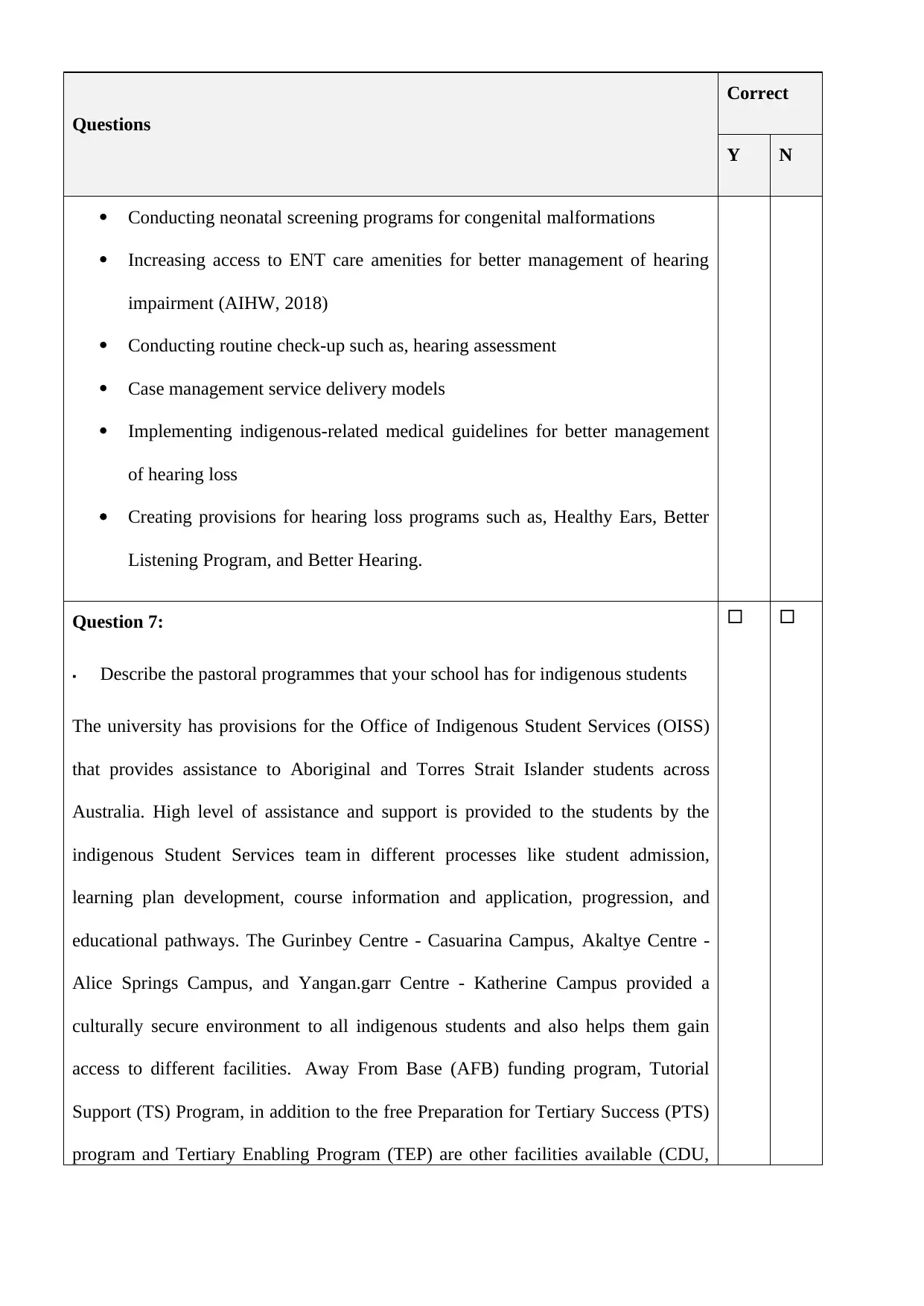
Questions
Correct
Y N
Conducting neonatal screening programs for congenital malformations
Increasing access to ENT care amenities for better management of hearing
impairment (AIHW, 2018)
Conducting routine check-up such as, hearing assessment
Case management service delivery models
Implementing indigenous-related medical guidelines for better management
of hearing loss
Creating provisions for hearing loss programs such as, Healthy Ears, Better
Listening Program, and Better Hearing.
Question 7:
Describe the pastoral programmes that your school has for indigenous students
The university has provisions for the Office of Indigenous Student Services (OISS)
that provides assistance to Aboriginal and Torres Strait Islander students across
Australia. High level of assistance and support is provided to the students by the
indigenous Student Services team in different processes like student admission,
learning plan development, course information and application, progression, and
educational pathways. The Gurinbey Centre - Casuarina Campus, Akaltye Centre -
Alice Springs Campus, and Yangan.garr Centre - Katherine Campus provided a
culturally secure environment to all indigenous students and also helps them gain
access to different facilities. Away From Base (AFB) funding program, Tutorial
Support (TS) Program, in addition to the free Preparation for Tertiary Success (PTS)
program and Tertiary Enabling Program (TEP) are other facilities available (CDU,
Correct
Y N
Conducting neonatal screening programs for congenital malformations
Increasing access to ENT care amenities for better management of hearing
impairment (AIHW, 2018)
Conducting routine check-up such as, hearing assessment
Case management service delivery models
Implementing indigenous-related medical guidelines for better management
of hearing loss
Creating provisions for hearing loss programs such as, Healthy Ears, Better
Listening Program, and Better Hearing.
Question 7:
Describe the pastoral programmes that your school has for indigenous students
The university has provisions for the Office of Indigenous Student Services (OISS)
that provides assistance to Aboriginal and Torres Strait Islander students across
Australia. High level of assistance and support is provided to the students by the
indigenous Student Services team in different processes like student admission,
learning plan development, course information and application, progression, and
educational pathways. The Gurinbey Centre - Casuarina Campus, Akaltye Centre -
Alice Springs Campus, and Yangan.garr Centre - Katherine Campus provided a
culturally secure environment to all indigenous students and also helps them gain
access to different facilities. Away From Base (AFB) funding program, Tutorial
Support (TS) Program, in addition to the free Preparation for Tertiary Success (PTS)
program and Tertiary Enabling Program (TEP) are other facilities available (CDU,
Paraphrase This Document
Need a fresh take? Get an instant paraphrase of this document with our AI Paraphraser
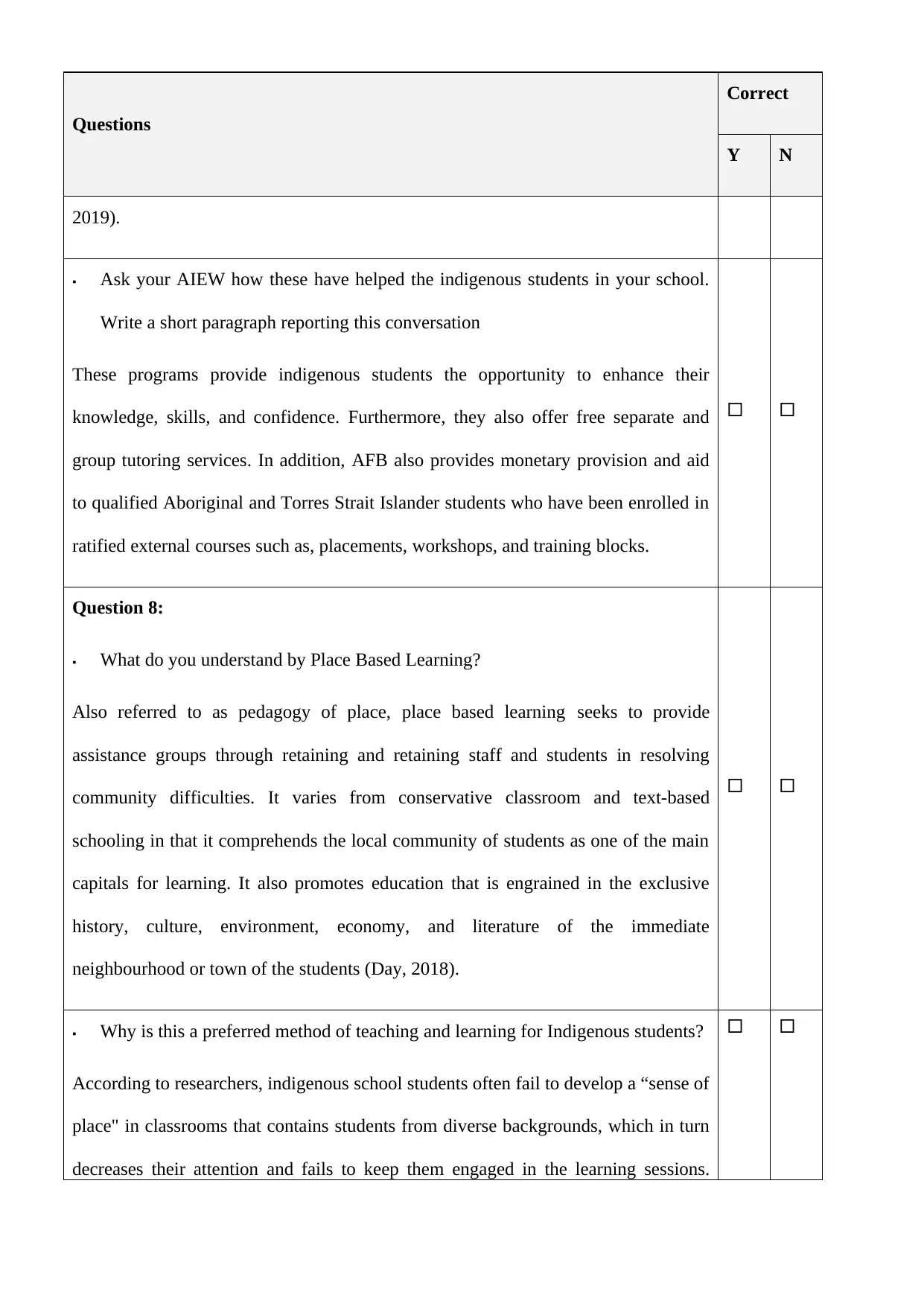
Questions
Correct
Y N
2019).
Ask your AIEW how these have helped the indigenous students in your school.
Write a short paragraph reporting this conversation
These programs provide indigenous students the opportunity to enhance their
knowledge, skills, and confidence. Furthermore, they also offer free separate and
group tutoring services. In addition, AFB also provides monetary provision and aid
to qualified Aboriginal and Torres Strait Islander students who have been enrolled in
ratified external courses such as, placements, workshops, and training blocks.
Question 8:
What do you understand by Place Based Learning?
Also referred to as pedagogy of place, place based learning seeks to provide
assistance groups through retaining and retaining staff and students in resolving
community difficulties. It varies from conservative classroom and text-based
schooling in that it comprehends the local community of students as one of the main
capitals for learning. It also promotes education that is engrained in the exclusive
history, culture, environment, economy, and literature of the immediate
neighbourhood or town of the students (Day, 2018).
Why is this a preferred method of teaching and learning for Indigenous students?
According to researchers, indigenous school students often fail to develop a “sense of
place" in classrooms that contains students from diverse backgrounds, which in turn
decreases their attention and fails to keep them engaged in the learning sessions.
Correct
Y N
2019).
Ask your AIEW how these have helped the indigenous students in your school.
Write a short paragraph reporting this conversation
These programs provide indigenous students the opportunity to enhance their
knowledge, skills, and confidence. Furthermore, they also offer free separate and
group tutoring services. In addition, AFB also provides monetary provision and aid
to qualified Aboriginal and Torres Strait Islander students who have been enrolled in
ratified external courses such as, placements, workshops, and training blocks.
Question 8:
What do you understand by Place Based Learning?
Also referred to as pedagogy of place, place based learning seeks to provide
assistance groups through retaining and retaining staff and students in resolving
community difficulties. It varies from conservative classroom and text-based
schooling in that it comprehends the local community of students as one of the main
capitals for learning. It also promotes education that is engrained in the exclusive
history, culture, environment, economy, and literature of the immediate
neighbourhood or town of the students (Day, 2018).
Why is this a preferred method of teaching and learning for Indigenous students?
According to researchers, indigenous school students often fail to develop a “sense of
place" in classrooms that contains students from diverse backgrounds, which in turn
decreases their attention and fails to keep them engaged in the learning sessions.
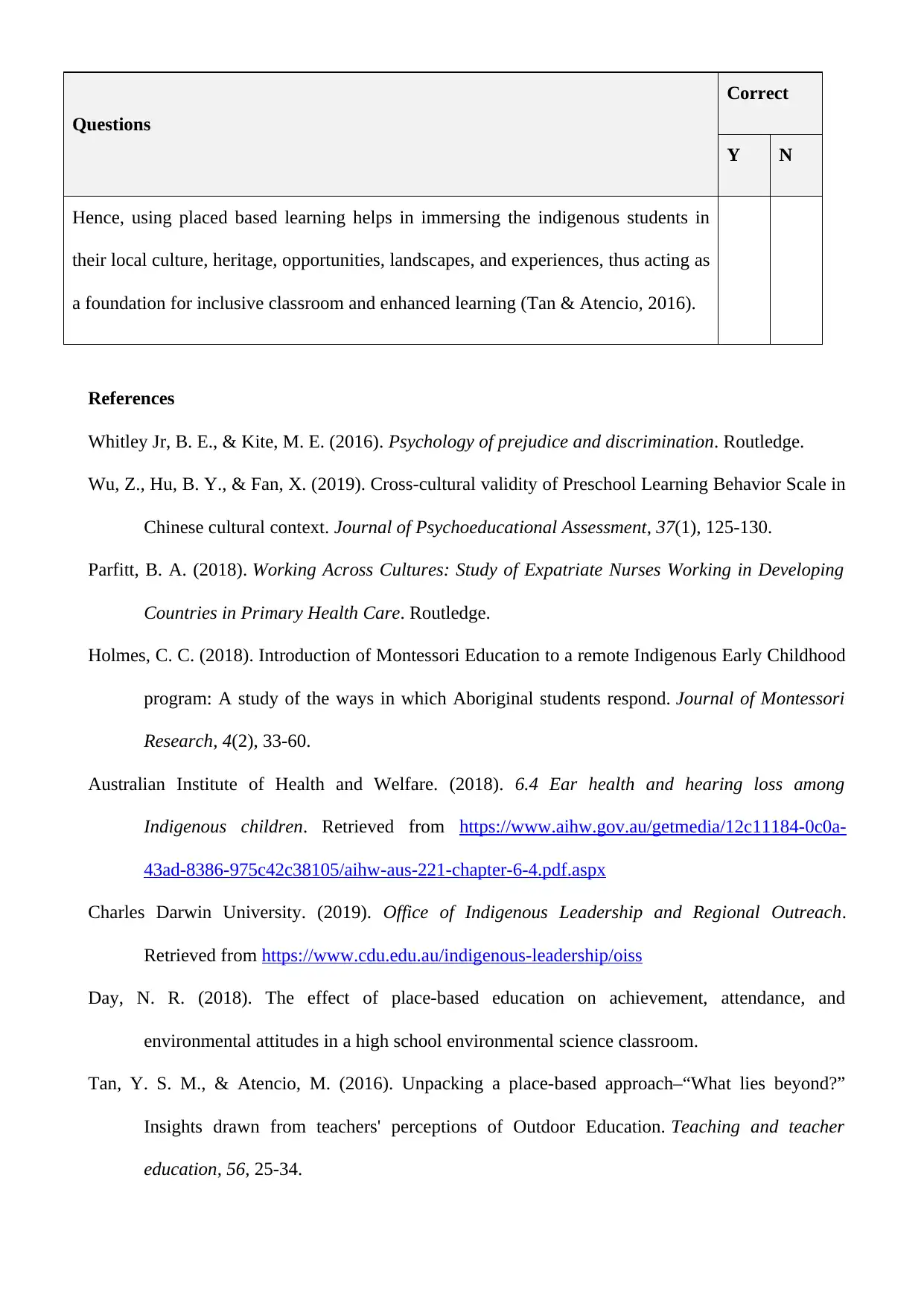
Questions
Correct
Y N
Hence, using placed based learning helps in immersing the indigenous students in
their local culture, heritage, opportunities, landscapes, and experiences, thus acting as
a foundation for inclusive classroom and enhanced learning (Tan & Atencio, 2016).
References
Whitley Jr, B. E., & Kite, M. E. (2016). Psychology of prejudice and discrimination. Routledge.
Wu, Z., Hu, B. Y., & Fan, X. (2019). Cross-cultural validity of Preschool Learning Behavior Scale in
Chinese cultural context. Journal of Psychoeducational Assessment, 37(1), 125-130.
Parfitt, B. A. (2018). Working Across Cultures: Study of Expatriate Nurses Working in Developing
Countries in Primary Health Care. Routledge.
Holmes, C. C. (2018). Introduction of Montessori Education to a remote Indigenous Early Childhood
program: A study of the ways in which Aboriginal students respond. Journal of Montessori
Research, 4(2), 33-60.
Australian Institute of Health and Welfare. (2018). 6.4 Ear health and hearing loss among
Indigenous children. Retrieved from https://www.aihw.gov.au/getmedia/12c11184-0c0a-
43ad-8386-975c42c38105/aihw-aus-221-chapter-6-4.pdf.aspx
Charles Darwin University. (2019). Office of Indigenous Leadership and Regional Outreach.
Retrieved from https://www.cdu.edu.au/indigenous-leadership/oiss
Day, N. R. (2018). The effect of place-based education on achievement, attendance, and
environmental attitudes in a high school environmental science classroom.
Tan, Y. S. M., & Atencio, M. (2016). Unpacking a place-based approach–“What lies beyond?”
Insights drawn from teachers' perceptions of Outdoor Education. Teaching and teacher
education, 56, 25-34.
Correct
Y N
Hence, using placed based learning helps in immersing the indigenous students in
their local culture, heritage, opportunities, landscapes, and experiences, thus acting as
a foundation for inclusive classroom and enhanced learning (Tan & Atencio, 2016).
References
Whitley Jr, B. E., & Kite, M. E. (2016). Psychology of prejudice and discrimination. Routledge.
Wu, Z., Hu, B. Y., & Fan, X. (2019). Cross-cultural validity of Preschool Learning Behavior Scale in
Chinese cultural context. Journal of Psychoeducational Assessment, 37(1), 125-130.
Parfitt, B. A. (2018). Working Across Cultures: Study of Expatriate Nurses Working in Developing
Countries in Primary Health Care. Routledge.
Holmes, C. C. (2018). Introduction of Montessori Education to a remote Indigenous Early Childhood
program: A study of the ways in which Aboriginal students respond. Journal of Montessori
Research, 4(2), 33-60.
Australian Institute of Health and Welfare. (2018). 6.4 Ear health and hearing loss among
Indigenous children. Retrieved from https://www.aihw.gov.au/getmedia/12c11184-0c0a-
43ad-8386-975c42c38105/aihw-aus-221-chapter-6-4.pdf.aspx
Charles Darwin University. (2019). Office of Indigenous Leadership and Regional Outreach.
Retrieved from https://www.cdu.edu.au/indigenous-leadership/oiss
Day, N. R. (2018). The effect of place-based education on achievement, attendance, and
environmental attitudes in a high school environmental science classroom.
Tan, Y. S. M., & Atencio, M. (2016). Unpacking a place-based approach–“What lies beyond?”
Insights drawn from teachers' perceptions of Outdoor Education. Teaching and teacher
education, 56, 25-34.
1 out of 9
Related Documents
Your All-in-One AI-Powered Toolkit for Academic Success.
+13062052269
info@desklib.com
Available 24*7 on WhatsApp / Email
![[object Object]](/_next/static/media/star-bottom.7253800d.svg)
Unlock your academic potential
© 2024 | Zucol Services PVT LTD | All rights reserved.





